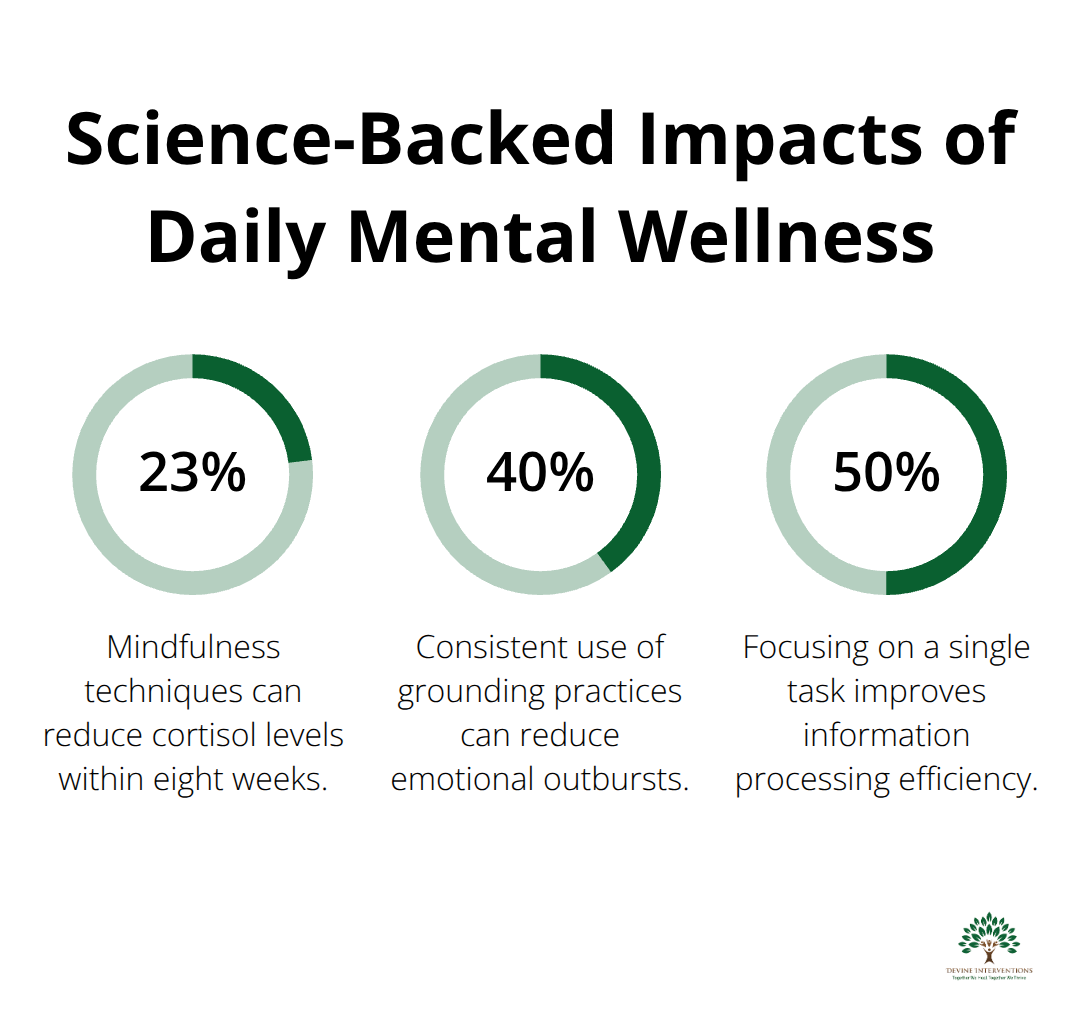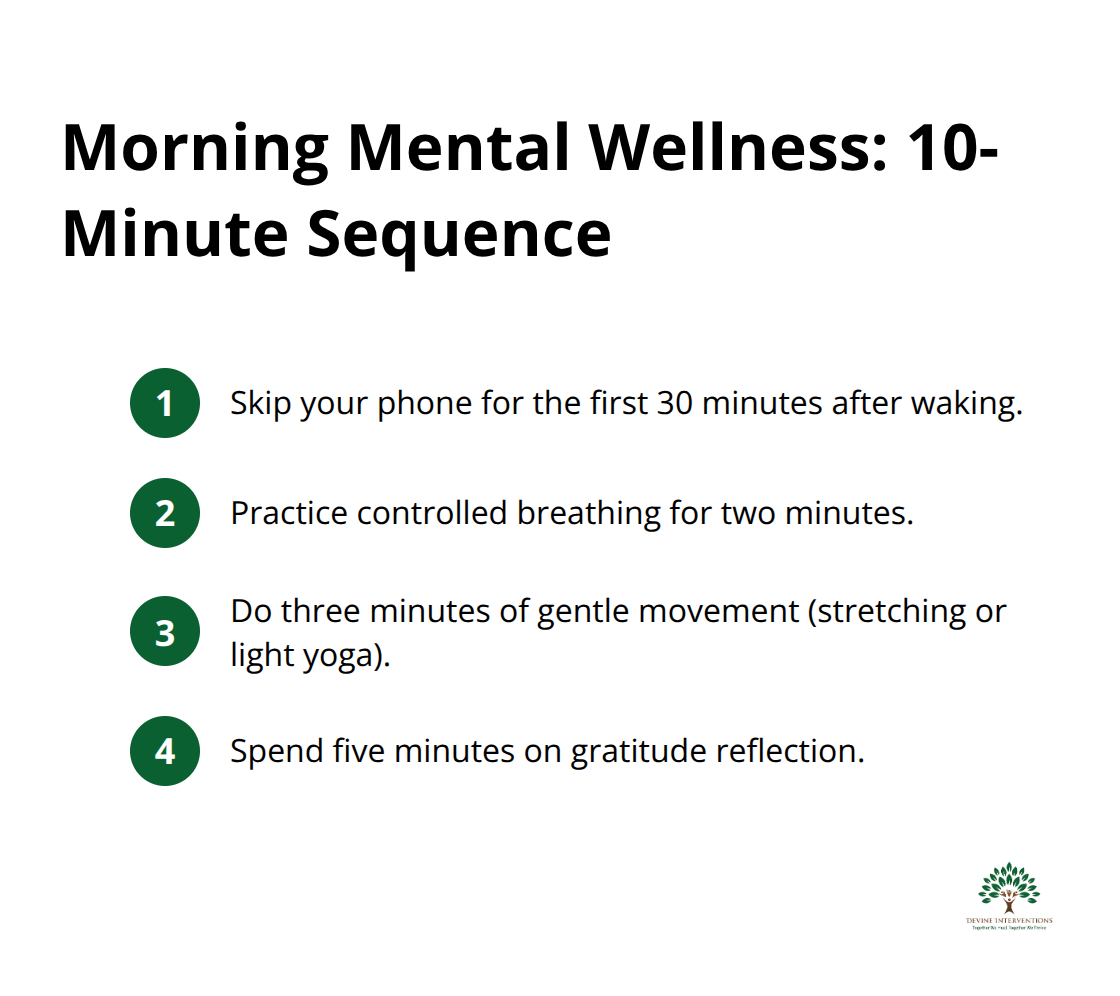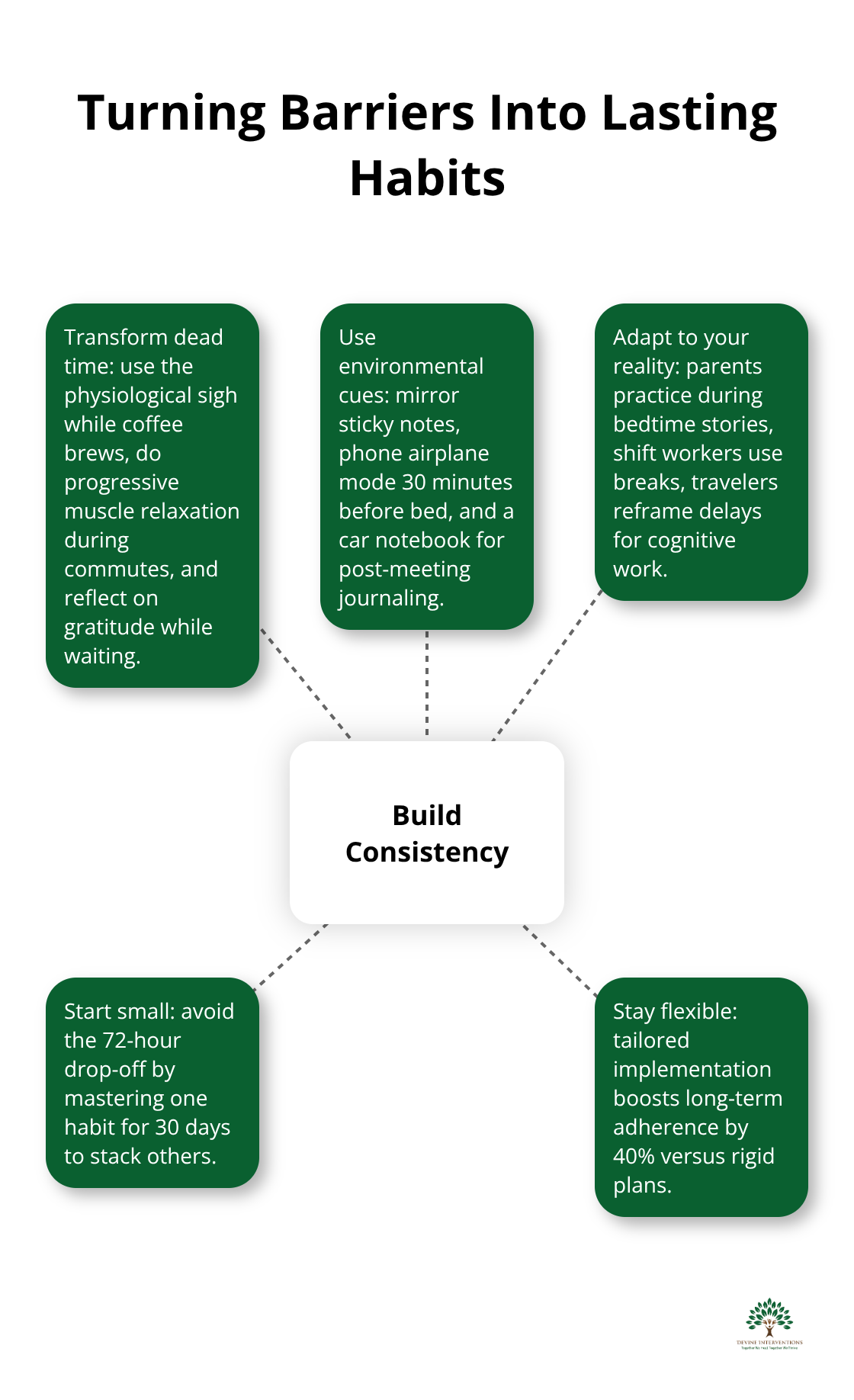Mental health challenges affect 1 in 5 adults annually, yet many struggle to find practical ways to support their wellbeing daily. Research shows that consistent mental wellness exercises can reduce anxiety by up to 60% and improve overall life satisfaction.
We at Devine Interventions understand that building sustainable mental health practices requires more than good intentions. This guide provides evidence-based techniques you can implement immediately, regardless of your schedule or experience level.
Science-Based Mental Wellness Exercises
Harvard Medical School research demonstrates that specific mindfulness techniques reduce cortisol levels by 23% within eight weeks of consistent practice. The 4-7-8 method, developed by Dr. Andrew Weil, activates the parasympathetic nervous system in under two minutes. These aren’t theoretical concepts – they’re measurable interventions that create immediate physiological changes in your stress response system.

Mindfulness That Fits Your Schedule
The 5-4-3-2-1 technique requires zero preparation and works anywhere. Identify five things you can see, four you can touch, three you can hear, two you can smell, and one you can taste. This sensory approach interrupts anxiety spirals within 60 seconds. Research shows that consistent practice of these techniques can reduce emotional outbursts by 40%.
Single tasks beat multitasks every time – your brain processes information 50% more efficiently when focused on one activity. Transform routine activities like meals or walks into mindfulness exercises. Pay complete attention to physical sensations and environmental details (the texture of food, the rhythm of your steps).
Immediate Relief Through Controlled Patterns
Box patterns, used by Navy SEALs, involve four-count inhales, four-count holds, four-count exhales, and four-count empty holds. This pattern reduces heart rate variability and stress hormones within three minutes. The physiological 4-7-8 technique works faster: inhale through your nose for four counts, hold for seven, exhale through your mouth for eight. Repeat four times maximum to avoid lightheadedness.
Using the 4-7-8 breathing technique helps maintain physiological calm. These techniques work because they shift your nervous system from fight-or-flight to rest-and-digest mode.
Cognitive Restructuring for Daily Challenges
Thought records identify cognitive distortions before they spiral into emotional overwhelm. Write down the situation that triggered you, your automatic thought, the emotion it creates, and evidence for and against that thought. This process, validated by over 500 clinical trials, reduces depressive symptoms by 50% when practiced consistently.
Challenge catastrophic thoughts with this question: What would I tell a friend in this situation? This simple reframe activates your prefrontal cortex and reduces amygdala reactivity by 30% (according to UCLA neuroimaging studies). The shift from emotional to logical processing happens within minutes of consistent practice.
These evidence-based techniques form the foundation of effective mental wellness practice, but implementation requires strategic planning that fits your unique lifestyle and schedule.
Creating a Sustainable Daily Mental Wellness Routine
Your nervous system operates on predictable patterns that respond to consistent cues throughout the day. Research shows that high-intensity yoga performed twice weekly is the most effective exercise regimen to improve sleep quality. The key lies in creating three distinct transition points that signal safety to your brain: morning activation, midday reset, and evening decompression.
Morning Mental Health Practices
Skip the phone for the first 30 minutes after waking. Instead, establish a 10-minute morning sequence: two minutes of controlled breathing, three minutes of gentle movement (stretching or light yoga), and five minutes of gratitude reflection.

This sequence activates your prefrontal cortex before your amygdala takes control. Write down three specific things you appreciate about yesterday – not general concepts, but concrete moments or interactions. This practice creates positive neural pathways that persist throughout the day.
Workplace Stress Management Strategies
Set hourly phone alarms for 30-second breathing resets. Brief interruptions every 60 minutes prevent stress hormone accumulation and maintain cognitive performance versus the typical afternoon decline. Use the physiological sigh technique: two inhales through the nose (one deep, followed by a shorter “top-up”) and then a slow exhale through the mouth.
This pattern reduces real-time stress markers within 90 seconds. Transform bathroom breaks into mindfulness moments (focus entirely on physical sensations and environmental sounds for two minutes). This micro-meditation approach reduces workplace anxiety when practiced consistently for three weeks.
Evening Wind-Down Techniques
Begin your wind-down routine exactly 90 minutes before intended sleep time. Consistent evening routines improve sleep quality and reduce next-day anxiety. Dim all lights to 30% brightness and avoid screens completely during this window – blue light exposure after 8 PM delays melatonin production.
Spend 15 minutes writing down tomorrow’s top three priorities and any lingering concerns from today. This brain dump technique reduces rumination and improves sleep onset time. End with progressive muscle relaxation starting from your toes and working upward, tensing each muscle group for five seconds before releasing.
Even the most effective routines face real-world obstacles that can derail your progress before it begins.
Overcoming Common Barriers to Mental Wellness Practice
Most people abandon mental wellness routines within 72 hours, not because the techniques don’t work, but because they set unrealistic expectations. Stanford research shows that individuals who practiced a single wellness habit for 30 days were 50% more likely to adopt additional habits. The solution isn’t finding more time – it’s using existing moments differently.

Transform Dead Time Into Wellness Windows
Your daily routine already contains 15-20 minutes of dead time that requires zero schedule changes. Practice the physiological sigh while your coffee brews (90 seconds), do progressive muscle relaxation during your commute as a passenger, or complete a gratitude reflection while you wait for appointments. UCLA studies demonstrate that these micro-interventions create the same neurological benefits as longer sessions when you practice them consistently for 21 days.
Replace social media scrolling during bathroom breaks with the 5-4-3-2-1 technique. This single swap eliminates the most common excuse for skipping wellness practices. Dead time becomes active recovery time when you approach it strategically.
Build Consistency Through Environmental Cues
Motivation fails because it requires daily decision-making, but environmental cues create automatic responses. Place a sticky note on your bathroom mirror for morning exercises, set your phone to airplane mode 30 minutes before bed as an evening routine trigger, or keep a small notebook in your car for stress-relief journaling after difficult meetings.
Visual cues create powerful behavioral changes when implemented consistently. Link new wellness practices to existing strong habits – if you never miss brushing your teeth, practice mindful breathing immediately afterward. This approach leverages established neural pathways instead of creating entirely new ones.
Adapt Techniques to Your Reality
Parents with young children can practice breath work during bedtime stories, shift workers can use progressive muscle relaxation during break periods regardless of time of day, and frequent travelers can implement cognitive restructuring techniques during flight delays. The key lies in matching technique intensity to your current capacity.
High-stress periods require simpler interventions, while stable periods allow for more complex practices. Research from the American Psychological Association shows that flexible implementation increases long-term adherence by 40% compared to rigid approaches. Your wellness practice should bend with your life circumstances, not break under pressure.
Creating a supportive environment plays a significant role in maintaining consistency. The most effective strategy involves identifying your specific obstacle patterns first, then building targeted solutions around them.
Final Thoughts
Regular mental wellness exercises create measurable changes in brain structure and function within 30 days of consistent practice. Studies show participants experience 40% less anxiety, improved sleep quality, and enhanced emotional regulation. These aren’t temporary fixes – they represent permanent upgrades to your mental operating system.
Mental wellness requires the same approach as physical fitness. Start small, stay consistent, and gradually increase intensity. Your brain adapts to whatever you practice most frequently (neuroplasticity works in your favor when you prioritize daily mental wellness exercises).
Professional support becomes necessary when daily function suffers despite consistent self-care efforts. Warning signs include persistent sleep disruption, inability to concentrate at work, or withdrawal from relationships that lasts more than two weeks. We at Devine Interventions provide comprehensive mental health services to support your journey toward lasting wellness. Contact us today to begin your path toward recovery and improved mental health.







